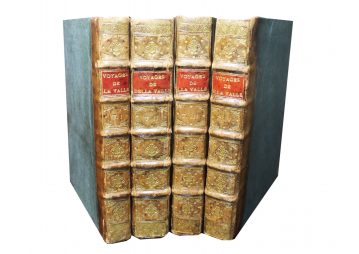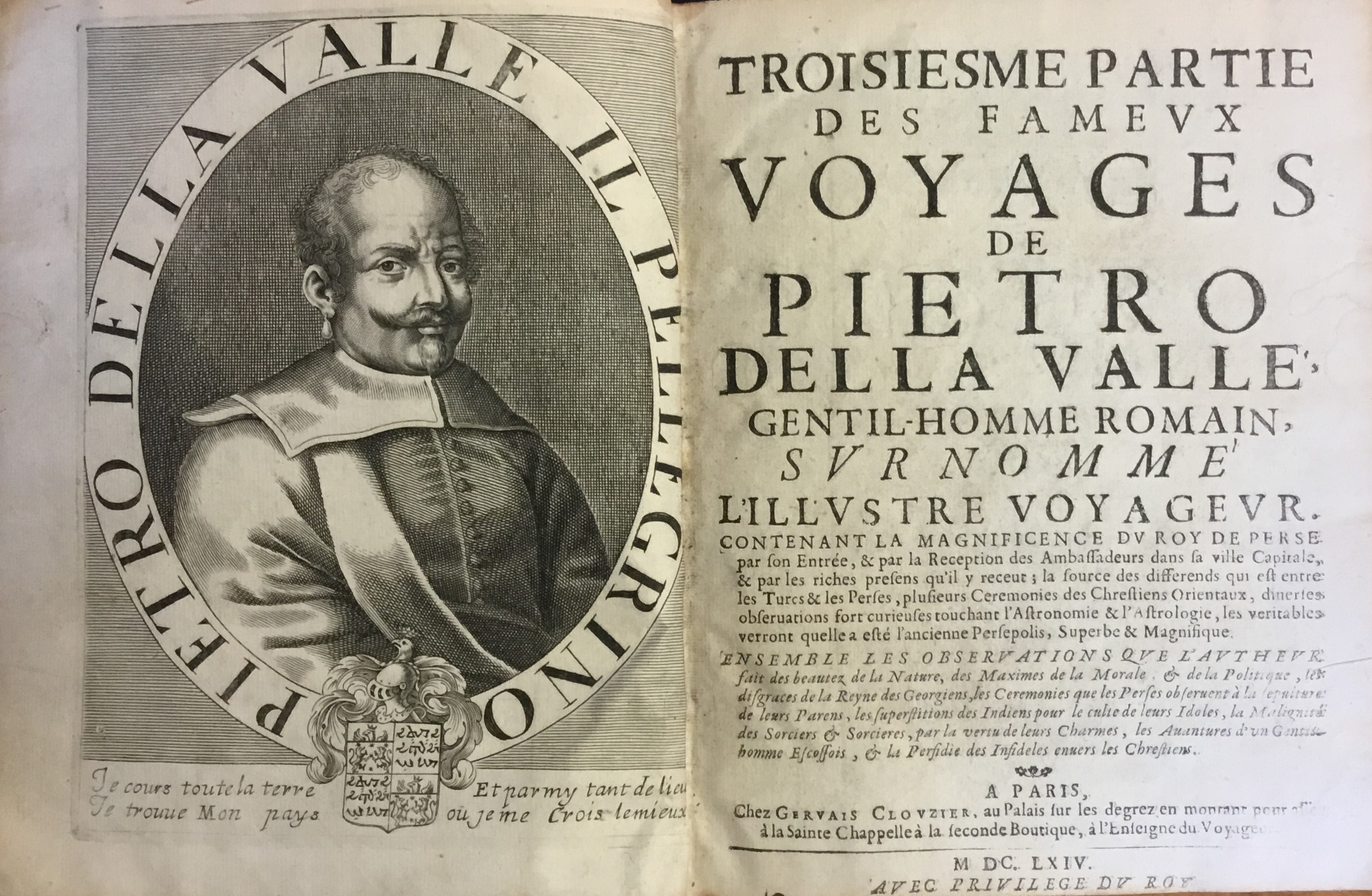Les Fameux Voyages de Pietro Della Valle, gentil-homme Romain, surnommé l’illustre voyageur, avec un denombrement tres-exact des choses les plus curieuses, & les plus remarquables qu’il a veuës dans la Turquie, l’Egypte, la Palestine, la Perse, & les Indes Orientales, & que les autheurs qui en ont cy devant éscrit, n’ont jamais observées, qreueus, corrigez & augmentez en cette Seconde Edition d’Arguments a chaque lettre; d’Additions en la marge, & autres choses fort curieuses, qui auoient este oblimse en la premiere impression. FOUR VOLUMES.
Della Valle, Pietro.
Synopsis
One of the classic early European accounts of Arabia and India. Valle’s writings (1586-1652) are considered the richest, most sophisticated contemporary record we have of the state of the world in the first quarter of the 17th century. The first edition of this work appeared in Italian in Rome 1650-63. The French translation was made by Etienne Carneau and François Le Comte and first appeared 1661-64. Della Valle set off for Constantinople in June 1614, eventually spending over a year there, and from Constantinople he sailed for Alexandria; he visited Cairo and learned Arabic and Turkish. From Cairo he travelled to Gaza and Jerusalem and then north to Aleppo by way of Galilee and Damascus. In 1616 Della Valle travelled by the desert route to Baghdad, married an Iraqi girl from Babylon and together they continued to Isfahan and after a brave journey north, to the great plain of Mazandaran and Gilan. He secured an interview with Shah Abbas whose seductive qualities, combining power, charm and eccentricity, kept him in Persia for six years. He wrote a great portrait of Shah Abbas and he visited Qazwin, Tehran and Shari. In October 1621, he left Isfahan for Oman and from there to India. He spent two years in India travelling home by way of Goa, Muscat and Aleppo. Valle settled in Rome as papal chamberlain, corresponding with the most distinguished Orientalists of his day. ‘His travels were among the most remarkable and most vividly recorded in an age of ceaseless journeying by Europeans undertaken primarily for commercial, diplomatic and religious reasons’.
Unlike most voyagers of the time, he was motivated by ethnographical, linguistic and artistic matters, rather than trade, conquest or missionary zeal. He signs himself here as “il pellegrino” (the Pilgrim), but in the largely secular sense of seeking to broaden his aristocratic, classical education by embracing the civilizations of the East – including eventually an eighteen year old girl from a Christian Nestorian community in Baghdad, whom he married in 1616 and whose death in childbirth in 1623 precipitated his return to Italy.
Della Valle first traced his voyage from Rome to Constantinople via Ancona, Bologna, Ferrara and Venice across to observe the great ruins of Troy (“…per dire meglio Campos ubi Troia fuit e vedute le gran ruine di quella famosa Città…”) and the Hellespont, pointing out Abydos and Sestos, made famous by the tale of Hero and Leander. He arrived in Constantinople on 15 August 1614 and described the opening of the Dardanelles at the Black Sea and Scutari.
He described his voyages as well as the cities he visited, including travelling with camels, which he judged much slower and more troublesome than horses. There is a dramatic description of crossing the River Mehi in India, using elephants and local oxen, made difficult by the converging currents from the river and the sea. Elsewhere he reported cultural, linguistic and artistic curiosities of the places he visited, often sending back examples of his finds to Italy. Many are still conserved in museums in Rome and Dresden. Della Valle’s travelogues were written and published, as a series of letters, in “Viaggi… descritti da lui medesimo in 54 lettere familiari” (Rome, 1650-58), and the work went through many editions.
Bibliographic references: Wing V4 8A- one of three issues. Ghani p.100. 1712 cites another edition, Tobler p. 95 cites and English folio edition 1665 and a German edition Geneva 1674; Rohricht 238.








